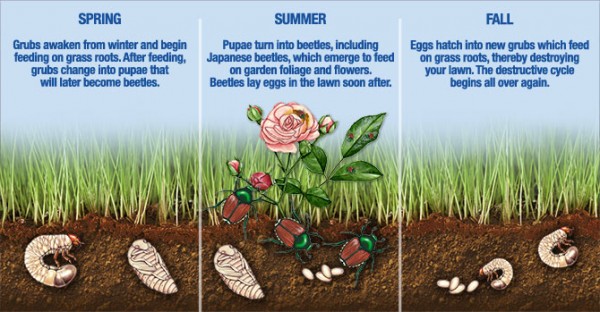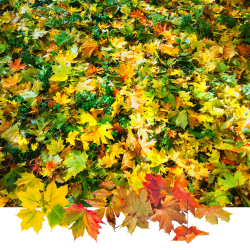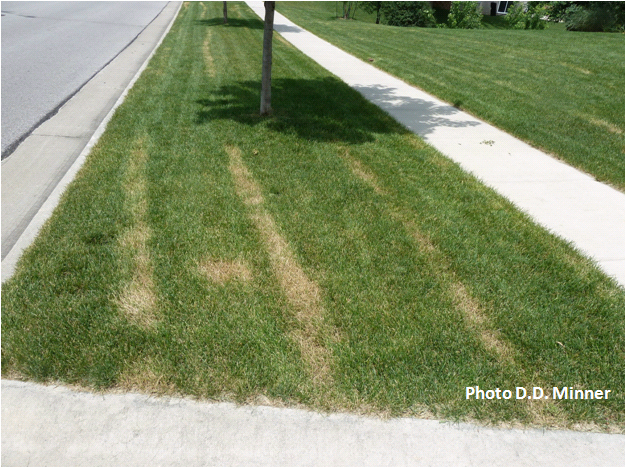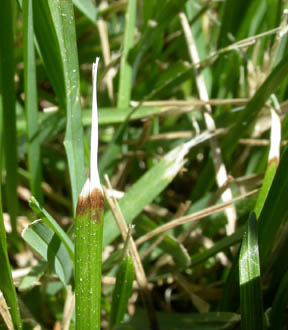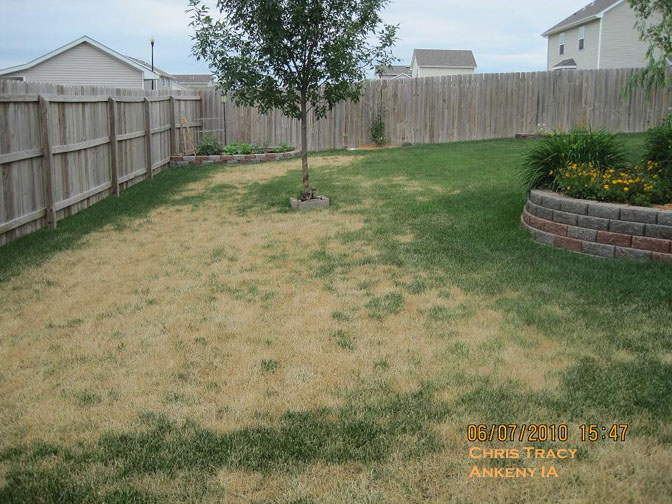
If you’re a gardener in Colorado, chances are you’ve encountered the voracious appetite of Japanese beetles wreaking havoc on your plants. These metallic green and copper-colored pests are more than just a nuisance. They can quickly decimate a garden if left unchecked. Let’s dive into what makes these beetles such a challenge for gardeners and how you can manage them effectively.
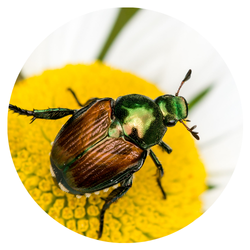
Identifying Japanese Beetles
Japanese beetles (Popillia japonica) are easily recognizable by their distinctive coloring: metallic green bodies with copper-brown wing covers. They are about half an inch long and have small white tufts of hair along their sides, which can sometimes resemble spots.
You’ll often find them congregating in groups on plants, particularly those with large leaves like roses, linden trees, and grapes.
Damage Caused by Japanese Beetles
These beetles are not picky eaters — they’re indiscriminate feeders. Their known diet includes over 300 plants. They chew through leaves, flowers, and even fruits, leaving behind skeletonized foliage that can quickly turn your once-vibrant garden into a ragged mess. Their feeding habits can weaken plants and make them more susceptible to other stressors, potentially leading to plant death in severe infestations.
Life Cycle of Japanese Beetles
Understanding the life cycle of Japanese beetles is crucial for effective management. They have a one-year life cycle that begins with eggs laid in the soil during mid-summer. These eggs hatch into grubs that feed on grass roots, causing damage to lawns and other grassy areas. By late spring of the following year, the grubs pupate and emerge as adult beetles, typically around June in Colorado.

Grub Stage Damage: Grubs feed on grassroots, which can lead to brown patches in lawns and weakened turf that easily pulls up like a loose carpet.
Adult Stage Damage: Adult beetles emerge and feed on foliage, flowers, and fruits, causing visible damage within days.
Protecting Your Landscape
Managing Japanese beetles requires a multi-pronged approach that addresses the damage they cause at each stage of their life cycle.
In the grub stage
Beetles will be burrowed into your lawn. There are a number of products available that target grubs in lawns and have proven to be effective against Japanese Beetles.
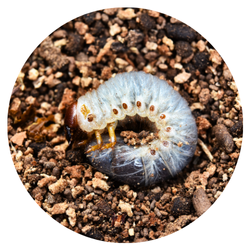
Products like Milky Spore (a bacterial disease of grubs), beneficial nematodes (parasitic organisms that target grubs), and grub control products such as GrubGONE! or GrubEX! can help reduce grub populations in the soil without harming beneficial insects.
Milky Spore (Paenibacillus popillae) is an organic product that is easy to use and will protect your landscape for the next ten years. It is a spore that affects Japanese Beetle grubs and nothing else! Yes, you read that right. It will not harm anything else in your garden. That means it can safely be used in the lawn, in the vegetable garden, and throughout your landscape. (Note: Expect this product to develop over time. It takes 3-4 years to build up enough of the spore disease to be noticeably effective)
Beneficial Nematodes (Heterorhabditis bacteriophora) seek out and kill all stages of harmful soil-dwelling insects — including Japanese Beetles. They are tiny worms found in soil that target young stages of pest insects, like larvae, grubs, nymphs, and pupae. They are a natural and effective alternative to chemical pesticides, and have no detrimental effect on non-target species such as ladybugs, earthworms and other helpful garden insects. Releasing the nematodes into your garden is a simple process. They are sold in an easy-release powder that dissolves quickly with water. For application, you can opt for a standard watering can or use a hose-end sprayer or pump sprayer to apply.
GrubGONE! is a natural and effective product with the main ingredient being Btg (Bacillus thuringiensis galleriae). Commonly found in nature, these bacteria can live and multiply within the bodies of insects, and produce spores and protein crystal toxins which can result in death of the insect host. It is a granular which should be applied in the spring, and then again in mid- to late summer when adult beetles will re-enter the turf to lay eggs and overwinter.
GrubEX! is a granular pesticide (Chlorantraniliprole 0.08%) that should be applied in spring or early summer. A single application can prevent grubs of all kinds from damaging your lawn all season long, especially killing the Japanese Beetle larvae (grubs) so they never get the chance to develop into adults.
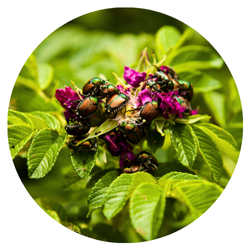
In the adult beetle stage
Japanese beetles will be actively flying and feeding on plant material in your landscape. A number of strategies can be employed to mitigate damage and get rid of the adult beetles.
Handpicking adult beetles can sometimes be effectively employed in small plantings. The beetles are easily picked or dislodged; shaking infested plants over a collecting container in early morning when temperatures are cool can be particularly productive. It is best to physically remove them from your plants with a gloved hand, but don’t squish them! Squished bugs emit pheromones, which end up attracting more beetles. Take the captured beetles and toss them in a bucket of soapy water.
BeetleGONE! is the first Bacillus thuringiensis galleriae (Btg) bio-insecticide to control adult beetles (plus the larvae or turf grubs) at a level of efficacy equivalent to chemical standards, but without the side effects or off-target damage to beneficial insects and pollinators. Unlike other biological or chemical grub-control products, BeetleGONE! can be used as a curative treatment for grub control as well as a preventative treatment. It works by making the foliage inedible to the beetles. This is a powder that you mix with water to apply. (Should be reapplied every 7-10 days)
Beetle traps, which use pheromones to attract beetles into a bag or container, can be controversial. While they can capture large numbers of beetles, they might also attract more beetles to your yard. If you choose to use traps, place them at least 30 feet away from your garden to draw beetles away from rather than into your plants.
Dealing with Japanese beetles requires vigilance and a strategic approach. By understanding their life cycle, identifying their damage, and employing a combination of cultural, biological, and if necessary, chemical controls, you can protect your garden from these invasive pests. Experiment with different methods to find what works best for your specific garden environment and remember to always follow product instructions carefully.
By taking proactive steps, being persistent, and staying informed, you can keep your garden thriving and beautiful, even in the face of challenges posed by Japanese beetles.
For a more detailed look at Japanese Beetles and possible controls, check out this informative fact sheet from the Colorado State University Extension:
Japanese Beetle Fact Sheet by Dr. Whitney Cranshaw
